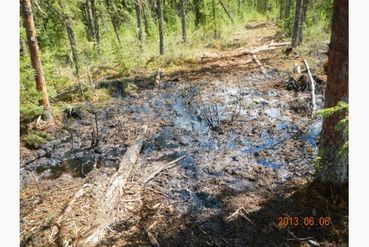The oil sands are extracted a number of ways. Initial operations begun more than a half century ago mined the sands in huge open pits where giant shovels dug up the sand for shipping to in situ processors that extracted the bitumen using chemicals and steam. These operations needed tons of freshwater and the net result is the enormous holding ponds that surround extraction operations, big enough to be seen from outer space.
But in the last thirty years new methods of extraction have been developed. One of these involves drilling and inserting pipes into bitumen deposits and using these pipes as conduits to inject high temperature-high pressure steam underground This separates the bitumen from the sand which then can be pumped out. Seen as more environmentally benign, based on headlines in Canadian papers over the last few weeks, the process is hardly that.
Since June 24 bitumen spills have been reported. The number so far is four covering an area about 40 hectares (approximately 100 acres). The operator is Canadian Natural Resources who on their site describe themselves as “committed to managing and minimizing the environmental impacts of our operations during all phases of our projects.”
Well it appears their operations up in Cold Lake, Alberta, have fallen well short of the mark. When I read about the spill I went to the company’s website seeking information on it. Nary a word in press releases or anywhere else on the site. Only the regulator in Alberta has publicly announced the incidents and has stated that “the incident is controlled, contained, all appropriate clean up and mitigation measures” are taking place.
But that isn’t true either. According to an article appearing in the Toronto Star today, the company has not contained the spill which is described as an “underground blowout.” The spill which first began in April has occurred in four locations within the Cold Lake Air Weapons Range, a restricted area within aboriginal-designated lands, traditional territory of the Beaver Lake Cree First Nation.
The extraction method called cyclic steam stimulation has been going on for some time. Thousands of liters of water are turned into steam which is then injected into the bitumen with cracks forming like in hydraulic fracturing. The oil separates from the sand and then flows into the cracks where it then can be collected and pumped through pipes to the surface.
In the Star article, an unnamed scientist who fears for his job is quoted as saying, “Everybody [at the company and in government] is freaking out about this….we don’t understand what happened. Nobody really understands how to stop it from leaking, or if they do, they haven’t put the measures into place.”
So far the cleanup team has removed 26,000 barrels of bitumen mixed with surface water, approximately 4,500 barrels of bitumen, dozens of dead animals including beavers and loons. For the Cree First Nation the concern is how much the spill could impact the plants and surrounding land as well as freshwater sources.
A spokesperson from Greenpeace has serious questions about the technology being used by Canadian Natural Resources. Keith Stewart, an energy analyst for the environmental organization and a teacher at University Toronto states, “You can’t cap it like a conventional oil well or turn off a valve on a pipeline….You are pressurizing the oil bed so hard that it’s no wonder that it blows out. This means that the oil will continue to leak until the well is no longer pressurized…” Just how long that will be is anybody’s guess.









